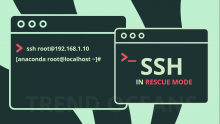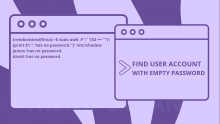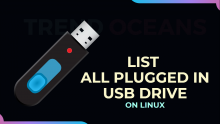Submitted by trendoceans on Wed, 05/17/2023 - 10:02
Want to remove the KDE Plasma environment from your Ubuntu machine and revert back to the default GNOME desktop environment, you just need to follow a few simple steps.
Read more
Submitted by trendoceans on Mon, 05/01/2023 - 08:46
When you updated your system repository, did you get an apt-key deprecation warning? If yes, then read this guide to resolve the apt-key deprecation warning message.
Read more
Submitted by trendoceans on Mon, 04/24/2023 - 10:12
Not sure what Ubuntu version you are using? Then read this guide to learn different ways to check your Ubuntu version.
Read more
Submitted by trendoceans on Wed, 10/05/2022 - 08:17
The touch Command Does Much More Than Just Create an Empty File
Read more
Submitted by trendoceans on Tue, 09/27/2022 - 07:20
This guide will not be helpful at the moment, but make sure to bookmark this article to enable ssh service in rescue mode to take a backup of your system, configuration, and generate an SOS report, etc.
Read more
Submitted by trendoceans on Mon, 09/26/2022 - 11:21
Want to install the latest mainline kernel update on your Ubuntu machine, which is still maintained by Linus Torvalds?
Read more
Submitted by trendoceans on Sat, 09/24/2022 - 12:02
Oh boy... there is another use of the find command which helps us to delete files according to access or modification time to remove unused files like a pro!
Read more
Submitted by trendoceans on Thu, 09/22/2022 - 12:32
In Linux computing, system security is the highest priority. Standard users or system administrators always take certain precautions to ensure the safety of the system and its users.
We have already discussed many topics related to system security (get the link at the bottom of this article). However, today we will focus on ensuring the safety of the user accounts.
Read more
Submitted by trendoceans on Thu, 09/22/2022 - 06:22
Nowadays, we can find many types of USB drives on the market, such as one can easily buy a USB drive the size of a credit card, which you can easily carry in your wallet, or a very micro-sized Pendrive that we have lost many times.
Sometimes we connect the thumb drive to our system and because of the missing led light, we are not able to understand whether the device is plugged in, or the USB port is working properly, or the system hasn’t detected the drive like that, there may be a number of questions starting to run through your mind.
Submitted by trendoceans on Wed, 09/21/2022 - 12:39
Don't you feel you should give some extra space around the terminal border? If yes, check how it looks after adding padding to the GNOME terminal.
Read more
Pages







